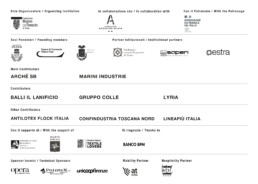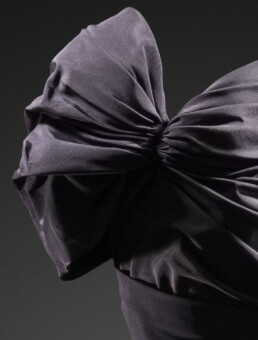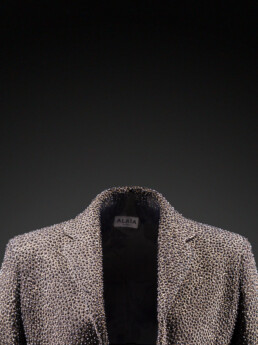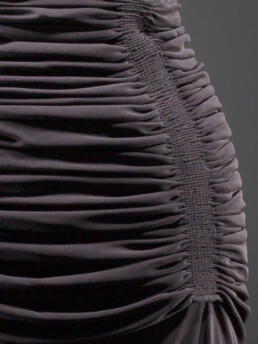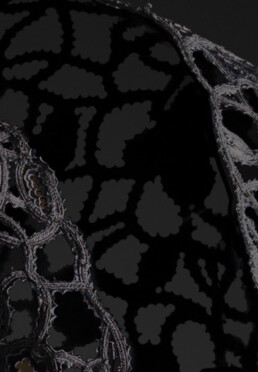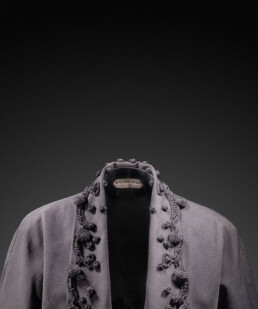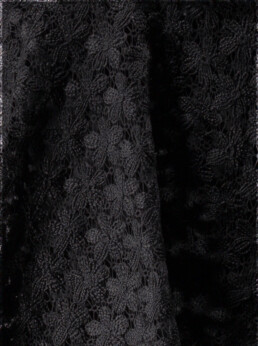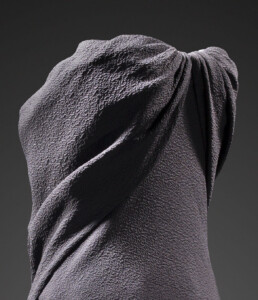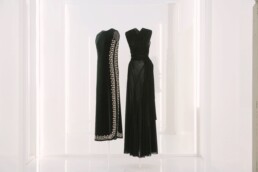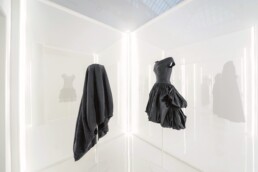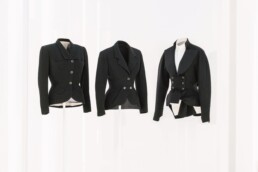Azzedine Alaïa, Cristóbal Balenciaga. Sculptors of shape
25 October 2025 - 3 May 2026
The Museum pays tribute to two iconic figures in French fashion with an exhibition designed by Olivier Saillard.
The Museo del Tessuto Foundation concludes its 50th anniversary exhibition calendar with a major exhibition dedicated to two absolute icons of French fashion. Created in collaboration with the Azzedine Alaïa Foundation in Paris chaired by Carla Sozzani, the exhibition Azzedine Alaïa and Cristóbal Balenciaga. Sculptors of Shape is curated by Olivier Saillard and counts the French Embassy in Italy among its patrons, as well as the extraordinary participation of Balenciaga Archives in Paris, for an exceptional exhibition project coming to Italy for the first time.
The concept for the exhibition dates back to the Azzedine Alaïa Foundation in 2020, at the behest of Hubert de Givenchy. A few months after the passing of Azzedine Alaïa (Tunis 1935 – Paris 2017) and decades after that of Balenciaga (Getaria 1895 – Jávea 1972), as a great admirer of Balenciaga and a key figure in classical fashion, Givenchy shared his wish with the Alaïa Foundation to bring these two great talents together, both skilled experimenters with shapes and volumes that have profoundly marked the history of fashion.
The exhibition
Twenty-five creations by Azzedine Alaïa – considered one of the last couturiers, capable of mastering every stage in a garment’s creation, from design to tailoring – dialogue with as many garments by Cristóbal Balenciaga, in a timeless comparison.
Alongside the garments, the Textile Museum is exhibiting 12 original drawings by Balenciaga dated between 1950 and 1968 from Balenciaga Archives in Paris, shown in Italy for the very first time. The drawings, some of which include technical notes for tailoring and fabric samples, are accompanied by an equal number of original photos of the garments being worn, valuable and extraordinary records of the Spanish designer’s creative process.
As Azzedine recounts, when Maison Balenciaga closed for good in 1968, as a young up-and-coming designer, he was called upon by Mademoiselle Renée – the Maison’s historic deputy general manager – to choose a selection of Master Balenciaga’s creations, because only his hands would be able to rework and renew them without betraying them. The young Alaïa was so amazed by the shapes, the architecture of the cuts and the technical skill of each garment that he marked this encounter with Balenciaga’s work as the starting point for his own, and personally collected his most representative garments.
Both couturiers were passionate about sartorial construction and known for their perfectionism and ability to cut and sew with their own hands. Balenciaga’s research resulted in perfect formal elegance, while Alaïa’s highlighted precise sensuality. Balenciaga was a great innovator of forms and creator of wearable architecture, while Alaia wrapped and sculpted the body as if it were a second skin.
The exhibition is completed by a film on the life and work of Azzedine Alaïa made by Joe McKenna, fashion editor and stylist, and a never-before-seen video featuring the presentations of Balenciaga’s Haute Couture Summer 1960 and 1968 collections from Balenciaga Archives in Paris.
Buy your ticket online. With this ticket you can visit all the permanent and temporary exhibitions.
The display itinerary
The exhibition opens with two iconic pieces, symbolizing Alaïa and Balenciaga’s two interpretations of femininity. Alongside these pieces, 12 original drawings by Balenciaga and videos from the Balenciaga Archives and Joe McKenna are displayed.
Continuing, the large exhibition hall houses the garments in three sections: “Atelier Tailleur,” “Atelier Flou,” and “Spagna.” In the tradition of French haute couture tailoring, there are two distinct departments: the Atelier Tailleur and the Atelier Flou. The former creates more structured garments, such as coats, tailored jackets, cape/dress suits, and frock coats, using rigorous tailoring techniques similar to those of menswear; the latter creates more fluid and soft garments, such as blouses, skirts, and dresses. It’s the realm of lightness, where delicate silk fabrics such as chiffon, mousseline, and organza are favored for evening wear, or wool crepe and fine knits for daytime.
The final section is dedicated to Spain. Flamenco, boleros, and lace are the recurring themes that conclude the exhibition, a true tribute to traditional Spanish clothing and the materials of the Mediterranean textile tradition.
The exhibition was created with the support of:
Municipality of Prato, Cassa di Risparmio di Prato Foundation, Saperi, Estra; General Directorate of Education, Research and Cultural Institutes of the Ministry of Culture, Tuscany Region, the companies of the Museo del Tessuto Textile Lovers.
We would like to thank the following for their significant project support:
Main Contributors
Arché sb, Marini Industrie
Contributors
Balli il Lanificio, Gruppo Colle, Lyria
Other Contributors
Antilotex Flock Italia, Confindustria Toscana Nord, Lineapiù Italia, as well as Banco BPM.
Technical sponsors:
Opera Laboratori, Pointex, Unicoop Firenze
Mobility partner:
Autolinee Toscane
Hospitality Partner:
Art Hotel Milano and Art Hotel Museo, Prato
Info
Visits
Temporary exhibition from 25 October 2025 to 3 May 2026
Stampa
Press Office:
Lara Facco P&C
E. press@larafacco.com | www.larafacco.com
Lara Facco | M. +39 349 2529989 | E. lara@larafacco.com
Stefania Arcari | M. +39 335 7440820 | E. stefania@larafacco.com
Lucio Serena | M. +41 76 304 84 13 | E. lucio@larafacco.com
Hashtag:
